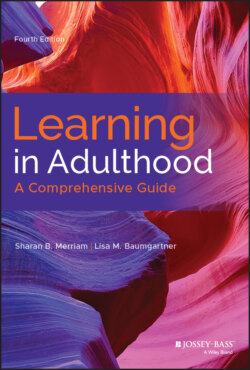Читать книгу Learning in Adulthood - Sharan B. Merriam - Страница 25
Blended Learning
ОглавлениеResearchers have not only created different learning theories for online learning, but delivery methods also vary. Blended learning has been defined in several ways. It can suggest the use of different technologies or various pedagogies to learn a subject or indicate combining types of technology such as learning information via videos with face-to-face training (Driscoll, 2002 as cited in Alammary, Sheard, & Carbone, 2014). Blended course design means that the course has “face-to-face and computer-mediated components,” which integrates various ways of instruction such as learning through lectures, discussion groups, or small group activities (p. 443). In this section, we discuss blended course design approaches, challenges, and best practices for teaching blended courses.
Alammary et al. (2014) state that there are low-, medium-, and high-impact blended course designs. The low-impact approach adds extra online activities to a face-to-face course without removing any face-to-face components. Although this is a quick and easy way for those who want to try blended learning, the course may seem like two courses—one traditional and one online because there is no reduction in the in-class portion. The medium-impact blend design replaces some face-to-face activities with web-based ones. This method is best for teachers who have taught the course in person several times so they know which in-class components can be replaced (Alammary et al., 2014). Building a blended course from scratch is the high-impact method with course activities that are typically designed around the learning outcomes. There is generally better integration of the online and face-to-face components because a whole course redesign makes teachers focus on the learner's needs in a way that the other designs may not. Teachers might try this method when they have some experience teaching blended courses and have ample time to design the course.
We have looked at the three methods of course design using blended learning, but what are some of the issues associated with teaching this way? Scholars reviewed eight articles from five countries that discussed the challenges of implementing blended learning in higher education institutions and the lessons learned (Ma'arop & Embi, 2016). Institutional concerns included getting students and faculty to adopt blended learning when they were used to teaching courses face-to-face. Instructors often lacked the skill necessary to design a blended course, and finding the balance between online and face-to-face instruction was difficult. The time required to create a blended learning course was also an issue for faculty. Student participation in blended learning required that students be more self-disciplined than in face-to-face courses. Solutions to these issues included properly analyzing the supports that institutions have before jumping into blended learning and carefully choosing which methods to use. Staff training, proper technical support, and an environment where teachers share ideas are all necessary to foster success. Students need similar technical assistance as well as support for time management skills (Ma'arop & Embi, 2016).
